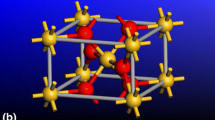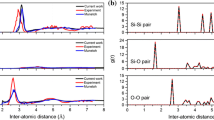Abstract
Recent studies have suggested that impact-induced devitrification of fused silica, or more specifically formation of high-density stishovite, can significantly improve ballistic-penetration resistance of fused silica, the material which is used in transparent armor. The studies have also shown that in order for stishovite to form during a ballistic-impact event, very high projectile kinetic energy normalized by the projectile/fused-silica target-plate contact area must accompany such an event. Otherwise fused-silica devitrification, if taking place, does not substantially improve the material ballistic-penetration resistance. In the present work, all-atom molecular-level computations are carried out in order to establish if pre-shocking of fused-silica target-plates (to form stishovite) and subsequent unloading (to revert stishovite to the material amorphous structure) can increase fused silica’s propensity for stishovite formation during a ballistic impact. Towards that end, molecular-level computational procedures are developed to simulate both the pre-shocking treatment of the fused-silica target-plate and its subsequent impact by a solid right-circular cylindrical projectile. The results obtained clearly revealed that when strong-enough shockwaves are used in the fused-silica target-plate pre-shocking procedure, the propensity of fused silica for stishovite formation during the subsequent ballistic impact is increased, as is the associated ballistic-penetration resistance. To rationalize these findings, a detailed post-processing microstructural analysis of the pre-shocked material is employed. The results obtained suggest that fused silica pre-shocked with shockwaves of sufficient strength retain some memory/embryos of stishovite, and these embryos facilitate stishovite formation during the subsequent ballistic impact.









Similar content being viewed by others
References
Zachariasen WH (1932) The atomic arrangement in glass. J Am Chem Soc 54(10):3841–3851
Alexander CS, Chhabildas LC, Reinhart WD, Templeton DW (2008) Changes to the shock response of quartz due to glass modification. Int J Impact Eng 35:1376–1385
Grujicic M, Pandurangan B, Coutris N, Cheeseman BA, Fountzoulas C, Patel P, Strassburger E (2008) A ballistic material model for Starphire®, a soda-lime transparent armor glass. Mater Sci Eng A 492:397–411
Grujicic M, Pandurangan B, Bell WC, Coutris N, Cheeseman BA, Fountzoulas C, Patel P (2009) An improved mechanical material model for ballistic soda-lime glass. J Mater Eng Perform 18:1012–1028
Grujicic M, Pandurangan B, Coutris N, Cheeseman BA, Fountzoulas C, Patel P (2009) A simple ballistic material model for soda-lime glass. Int J Impact Eng 36:386–401
Grujicic M, Bell WC, Glomski PS, Pandurangan B, Cheeseman BA, Fountzoulas C, Patel P, Templeton DW, Bishnoi KD (2011) Multi-length scale modeling of high-pressure induced phase transformations in soda-lime glass. J Mater Eng Perform 20:1144–1156
Grujicic M, Bell WC, Pandurangan B, Cheeseman BA, Fountzoulas C, Patel P (2012) Molecular-level simulations of shock generation and propagation in soda-lime glass. J Mater Eng Perform 21:1580–1590
Grujicic M, Bell WC, Pandurangan B, Cheeseman BA, Fountzoulas C, Patel P (2011) The effect of high-pressure densification on ballistic-penetration resistance of soda-lime glass. J Mater Des Appl 225:298–315
Grujicic M, Pandurangan B, Zhang Z, Bell WC, Gazonas GA, Patel P, Cheeseman BA (2012) Molecular-level analysis of shock-wave physics and derivation of the hugoniot relations for fused silica. J Mater Eng Perform 21:823–836
Grujicic M, Snipes JS, Ramaswami S, Yavari R, Barsoum RS (2015) Densification and devitrification of fused silica induced by ballistic impact: a computational investigation. J Nanomater. doi:10.1155/2015/650625
Chakraborty R, Dey A, Mukhopadhyay AK (2010) Loading rate effect on nanohardness of soda-lime-silica glass. Metall Mater Trans A 41:1301–1312
Tschauner O, Luo S-N, Asimow PD, Ahrens TJ (2006) Recovery of stishovite-structure at ambient conditions out of shock-generated amorphous silica. Am Miner 91:1857–1862
Salleo A, Taylor ST, Martin MC, Panero WR, Jeanloz R, Sands T, Génin FY (2003) Laser-driven formation of a high-pressure phase in amorphous silica. Nat Mater 2:796–800
Mantisi B, Tanguy A, Kermouche G, Barthel E (2012) Atomistic response of a model silica glass under shear and pressure. Eur Phys J B 85:304–316
Kubota A, Caturla M-J, Davila L, Stolken J, Sadigh B, Quong A, Rubenchik A, Feit MD (2002) Atomistic response of a model silica glass under shear and pressure. Laser-induced damage in optical materials 2001. In: Exarhos GJ, Guenther AH, Lewis KL, Soileau MJ, Stolz CJ (eds) Proceedings of SPIE, vol 4679, pp 108–116
Grujicic M, Avuthu V, Snipes JS, Ramaswami S, Galgalikar R (2015) The effect of high-pressure devitrification and densification on ballistic-penetration resistance of fused silica. J Mater Eng Perform 24(12):4890–4907
http://accelrys.com/products/datasheets/materials-visualizer.pdf. Accessed September 7, 2015
Tu YH, Tersoff J, Grinstein G, Vanderbilt D (1998) Properties of a continuous-random-network model for amorphous systems. Phys Rev Lett 81:4899–4902
Nosé S (1991) Constant temperature molecular dynamics methods. Prog Theor Phys Suppl 103:1–46
Grujicic M, Cao G, Singh R (2003) The effect of topological defects and oxygen adsorbates on the electronic transport properties of single-walled carbon nanotubes. Appl Surf Sci 211:166–183
Amirkhizi AV, Isaacs J, McGee J, Namet-Nasser S (2006) An experimentally-based viscoelastic constitutive model for polyurea including pressure and temperature effects. Phil Mag 86(36):5847–5866
Sun H (1998) COMPASS: an ab initio force-field optimized for condensed-phase applications overview with details on alkane and benzene compounds. J Phys Chem B 102:7338–7364
Sun H, Ren P, Fried JR (1998) The COMPASS force field: parameterization and validation for phosphazenes. Comput Theor Polym Sci 8:229–246
Grujicic M, Sun YP, Koudela KL (2007) The effect of covalent functionalization of carbon nanotube reinforcements on the atomic-level mechanical properties of poly-vinyl-ester-epoxy. Appl Surf Sci 253:3009–3021
http://accelrys.com/products/datasheets/discover.pdf. Accessed September 7, 2015
Grujicic M, Bell WC, Pandurangan B, Cheeseman BA, Patel P, Gazonas GA (2012) Inclusion of material nonlinearity and inelasticity into a continuum-level material model for soda-lime glass. J Mater Des 35:144–155
Grujicic M, Bell WC, Pandurangan B, Cheeseman BA, Patel P, Dehmer PG (2012) Effect of the tin- vs. air-side plate-glass orientation on the impact response and penetration resistance of a laminated transparent-armor structure. J Mater Des Appl 226:119–143
Grujicic M, Snipes JS, Ramaswami S, Yavari R, Barsoum RS (2015) All-atom molecular-level analysis of the ballistic-impact-induced densification and devitrification of fused silica. J Mater Eng Perform 24:2970–2983
Grujicic M, Pandurangan B, Coutris N (2012) A computational investigation of the multi-hit ballistic-protection performance of laminated transparent armor systems. J Mater Eng Perform 21:837–848
Grujicic M, Bell WC, Pandurangan B (2012) Design and material selection guidelines and strategies for transparent armor systems. J Mater Des 34:809–819
Acknowledgements
The material presented in this paper is based on work supported by the Office of Naval Research (ONR) research contract entitled “Reactive-Moiety Functionalization of Polyurea for Increased Shock-Mitigation Performance,” Contract Number N00014-14-1-0286. The authors would like to express their appreciation to Dr. Roshdy Barsoum, ONR, program sponsor, for many helpful discussions, guidance, and continuing interest.
Funding
This study was funded by the Office of Naval Research (ONR) research contract entitled “Reactive-Moiety Functionalization of Polyurea for Increased Shock-Mitigation Performance,” Contract Number N00014-14-1-0286.
Author information
Authors and Affiliations
Corresponding author
Ethics declarations
Conflict of interest
The authors declare that they have no conflict of interest.
Rights and permissions
About this article
Cite this article
Grujicic, M., Snipes, J.S. & Ramaswami, S. The effect of fused-silica pre-shocking on its devitrification propensity and ballistic resistance: an all-atom molecular-level analysis. J Mater Sci 51, 3500–3512 (2016). https://doi.org/10.1007/s10853-015-9670-0
Received:
Accepted:
Published:
Issue Date:
DOI: https://doi.org/10.1007/s10853-015-9670-0




